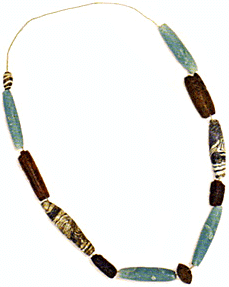...Best of Sicily presents... Best of Sicily Magazine. ... Dedicated to Sicilian art, culture, history, people, places and all things Sicilian. |
by Antonella Gallo | ||
Magazine Index Best of Sicily Arts & Culture Fashion Food & Wine History & Society About Us Travel Faqs Contact Map of Sicily |
Perhaps this should be placed in a more global context. By 1000 BC, one of the distinctions between the native North American civilisations (which migrated from Asian lands about 15,000 years ago) and certain Eurasian and African ones was that the woodland and plains "Indians" did not use metal to fashion tools. Farther south, certain American peoples (the Aztecs) did, but other developments, such as the Old World's extensive use of alphabetic written language and specific technologies (the wheel), also defined the differences between the American and Eurasian cultures. However, in viewing objects that pre-date the bronze-copper age, we're reminded of what these societies had in common --long ago. Prehistory was supplanted by "history" only when written language, however abstract, came into common use as a record of events and ideas. Back in Sicily, there were eastern Mediterranean influences as the Elymians and then Phoenicians and Greeks colonised the island. In time, the use of stones and bones as the primary elements of jewelry gave way to bronze, silver and gold, with rubies, emeralds and ivory as embellishments. Glass was also used. Not surprisingly, much of the Phoenician work bears the mark of Egyptian influences. We cannot know with certainty precisely when man first fashioned necklaces and other decorative jewelry, but estimates (based on actual archeological evidence) place this development at an early date indeed, long before mankind's arrival in Sicily. In the earliest historical period, a distinctly "Sicilian" style is difficult to discern, the ancient and medieval history of Sicily being that of a succession of conquerors. Clearly, fashion trends existed then as now, though it was a slower process. Pulcherrima Res is an exhibit of some of these objects at the Salinas Archeological Museum (Piazza Olivella, Palermo) through April 2006. The display includes neolithic, Elymian, Phoenician, Greek, Roman and Byzantine pieces found in Sicily. Some are simple, others are mythological and a few are Christian. All are beautiful. About the Author: Antonella Gallo, who teaches art in Rome, has written numerous articles on arts and artists for Best of Sicily. | |
Top of Page |
 How old is ancient? In Sicily, ten thousand years might be a good estimation --though this could be debated.
The necklace shown here (at left) is Phoenician, made circa 700 BC (BCE).
The shell necklace (right) is neolithic, dating from around 7,000 BC, or
about nine
How old is ancient? In Sicily, ten thousand years might be a good estimation --though this could be debated.
The necklace shown here (at left) is Phoenician, made circa 700 BC (BCE).
The shell necklace (right) is neolithic, dating from around 7,000 BC, or
about nine  thousand years ago, and the boar tusks are contemporary to the necklace. The neolithic
civilisation of Sicily culminated in the Proto-
thousand years ago, and the boar tusks are contemporary to the necklace. The neolithic
civilisation of Sicily culminated in the Proto-